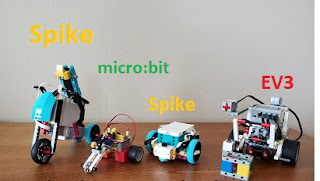Our dancers are the robots!
However having students "play" robot can help them understand how to program their robots.
Dances are just combination of repeated patterns.
- Some dances are simple To-and-Fro.
- Some dancers move around the dance floor.
- Some dancers like square dance mirror each others moves.
Dancing alone
To-and-Fro = Basic Opposite movements
- forward-backwards
- left-right turns
- including circles = 360 degree turn (and back)
- angular movements - there and back
- repeat a combination of moves
- may be opposites
- must not be all opposites
- moving around dance floor
- Add extra step at end of pattern to (slightly) change direction like:
- to and fro movements are not same in length
- extra turn
- extra partial circular turn
- How could you do a waltz?
- If "modern" dance, do all robots need to make the same moves?
- if don't make same move, what problems could arise?
Dancing together
Line Dances
- Robots start in a line facing forward doing same moves
- To-and-Fro
- All doing same pattern dance
Square Dances:
- Robots face each other
- Robots in circle
- Facing out
- Facing in (more precision needed)
- dance partners start together as defined by the dance pattern
- program so dancers stay together during dance
Mirroring moves = Keeping partners together
- If no program change .
- Enough space for both robots can go forward toward each other.
- Enough space for turns
- If Program opposite/ mirroring moves
- One goes forward and partner goes backwards
- One goes left and partner goes right
- Angular - to-and-from
- How would you mirror in program?
Dancing together Dancer Start positions
- in a line facing forward
- in a line in a follow-the-leader line-up
- in a circle facing forward
- in a circle in a follow-the-leader line-up
- some where on dance floor with enough room to make dance moves







